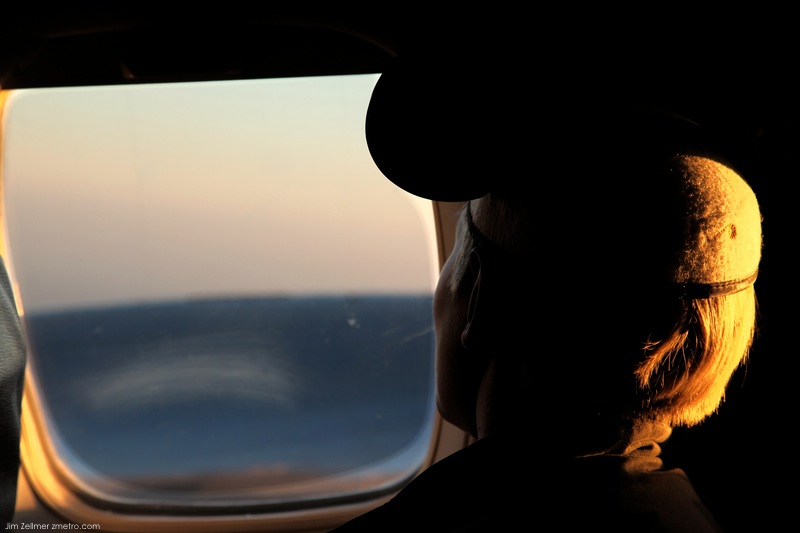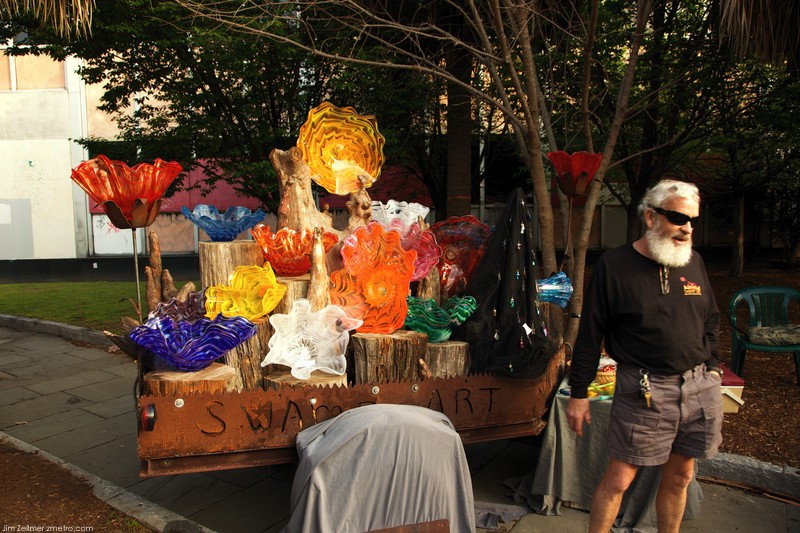My trip was significantly less copacetic – due to “fog” (read: noxious pollution) at Pudong no planes were landing. Our evening flight was cancelled, and the the next day’s flight delayed three or four hours. We ended up circling in Shanghai, landing in Hangzhou first, deplaning, and only later flying back to Shanghai. Total trip time: 23 hours.
I observed in my flight mates a similar kind of resignation that you saw – but I don’t think it is due to any sort of calmness. Instead I saw a powerlessness in front of authority. Again and again people on the plane turned to me and asked me to call my embassy – saying “they will pay attention to you. But they don’t care about us Chinese”. One passenger (shanghainese) demanded that they hurry us to Shanghai because we had so many foreigners on the plane, and it was a major loss of face for China. The awareness and sensitivity to the poor treatment of local travelers reached a fever pitch when the biscuits and water came to us as we cooled our heels in Hangzhou. One passenger erupted in fury “Where did that Japanese tour group go? Have you given them better food? Have you given them *noodles*? How dare you!”
(The gate attendant’s response is a topic for a whole other post. She, a young and pretty woman with trendy heavy glasses and a bejeweled mobile phone, turned to the angry passenger and said “of course we haven’t given the Japanese noodles! We will never forget the Nanjing Massacre!”….)
Category: Travel
East Germany, Up Close and Personal
When a West German photographer set off on a trip to the East German island of Rügen just after the Wall fell in the spring of 1990, he captured a world that would soon disappear forever. Twenty years after the epochal event, he looks back on his journey in a first-person account.
I remembered the painting from art class in school: The Chalk Cliffs on Rügen, by Caspar David Friedrich. It seemed legendary to me. On the one hand, I was fascinated by the colors, the pinks, the grays, the greens, and the shimmering blue of the water contrasting with the luminous white chalkstone. On the other hand, I was convinced that although I could always see the painting, I would never be able to contemplate the same scenery in reality. I wondered whether the landscape on the island of Rügen truly resembled the painting. It was a mystery to me.
Swamp Art
Why Sourdough is the Best Bread
San Francisco’s food scene is probably the most vibrant in the Americas. Whether they’re starting trends or perfecting them, Bay Area chefs have long been among the world’s most creative. But amidst all the innovation, there has been one faithful and beloved constant on the city’s many tables: sourdough bread.
It’s hard to find someone who doesn’t like sourdough, but even rarer are people who know what makes it so distinctive. It’s often thought to be a flavouring, or perhaps a baking technique, something pioneered in Gold Rush-era San Francisco. In fact, sourdough is simply bread in which the rise comes not from a package of shop-bought yeast, but from wild yeast that is in the air everywhere.
As the original leavened bread – all bread was “sourdough” until Louis Pasteur’s germ theory led to packaged yeast – sourdough has a long and storied past. But as a let-them-eat-cake epoch gives way to home pleasures and the local food movement, sourdough is equally suited to our own times. Classic, inexpensive and uniquely local, sourdough is as fascinating to kids and novices as it is to practiced bakers and mad scientists of all ages.
Sourdough is an ancient art, but with just two ingredients its simplicity is as remarkable as its heritage. Flour and water are mixed and left to stand on a windowsill or kitchen counter. In a matter of days wild yeast take over and the mixture begins to froth and bubble with life. If you’ve ever wondered at the origins of this or that cooking method – “who on Earth thought to try this?” – sourdough is that rare thing, a miraculous culinary phenomenon that won’t give you that feeling. With yeast naturally in the air, it’s easy to imagine how an afternoon’s forgetfulness in ancient Egypt led to the invention of leavened bread.
36 Hours in Hanoi
NEAR Hoan Kiem Lake in the heart of Hanoi, a digital clock counts down the seconds to this atmospheric city’s 1,000th birthday in 2010. There certainly will be a lot to celebrate: the city, Vietnam’s capital, has experienced extraordinary growth over the last two decades, evolving from a grim, famine-ravaged place into a sophisticated metropolis with high-rises, sensational cuisine and world-class art. Those shaking their heads at the disappearance of local culture, though, should think twice. For every glitzy mall, there’s an incense-filled temple nearby, and cultural influences of the past are still part of the modern-day fabric, from revered Confucian monuments to trendy French restaurants. In fact, it’s this zeal for barreling toward the future while always looking back that defines this city.
April Fools Jokes – a few days later…..
This stunning accommodation offers deluxe living in the heart of England’s capital city. A gated property with secure parking and armed guards, this is the perfect property to relax in complete luxury. Exquisitely furnished with many priceless antiques, royal collections and rare artefacts. 400 people work at the Palace to cater to your every need, including domestic servants, chefs, footmen, cleaners, plumbers, gardeners, chauffeurs, electricians, and two people who look after the 300 clocks.
The palace consists of 19 state rooms, 600 bedrooms and 78 bathrooms. There is an adequate sized banquet hall to entertain your guests in the evening and a throne room which is an unusual but popular additional feature.
The owners do reside in the property but are discreet and are available should you require any assistance. They also own other properties throughout the United Kingdom. Please contact them for further details.
More: The 10 Best April Fools’ Jokes and Econoland.
A Gorgeous Bird Video Short
from the Phillipines.
For Some Taxi Drivers, a Different Kind of Traffic
The tour guide’s voice dropped to a whisper as he pointed out the left side of his open-air taxi and said conspiratorially: “See that house? It belongs to Chapo.”
At the spot, where Mr. Félix’s brother Ramo?n was killed in 2002, in an infamous murder.
The State Department warns tourists about the drug wars.
The guide recovered his normal tone around the corner, well out of earshot of anyone who might be inside what he claimed was one of the beachfront hideaways of Mexico’s most wanted drug trafficker, Joaquín Guzmán Loera, who is known universally by the nickname El Chapo, or Shorty.
Although Mazatlán markets itself as a seaside paradise in which the roughest things one might encounter are ocean swells, it is a beach resort with a dark side — one that many enterprising taxi drivers are exploiting with unauthorized “narco-tours.”
Mexicans are fed up with their country’s unprecedented level of bloodshed as rival drug cartels clash with the authorities and among themselves. But the outrage is tinged by a fascination with the colorful lives of the outlaws.
I visited Mazatlan many years ago, during college.
108 Road Trips from Southern California
There’s nothing quite as all-American as a road trip, especially in the West, where a wealth of culture, natural beauty and excitement unfolds before you. Coyote Buttes awaits in Arizona. General Grant Tree beckons from the Sierra Nevada.
To help you tap the region’s cache of getaways, we’ve compiled a list of 108 road trip spots. Distance to each destination is one-way from downtown Los Angeles. Cost of gas is for a round trip.*
Returning Home From a Disney Birthday

I snapped this photo while sitting near a mother and son flying home from a Disneyland birthday trip.
